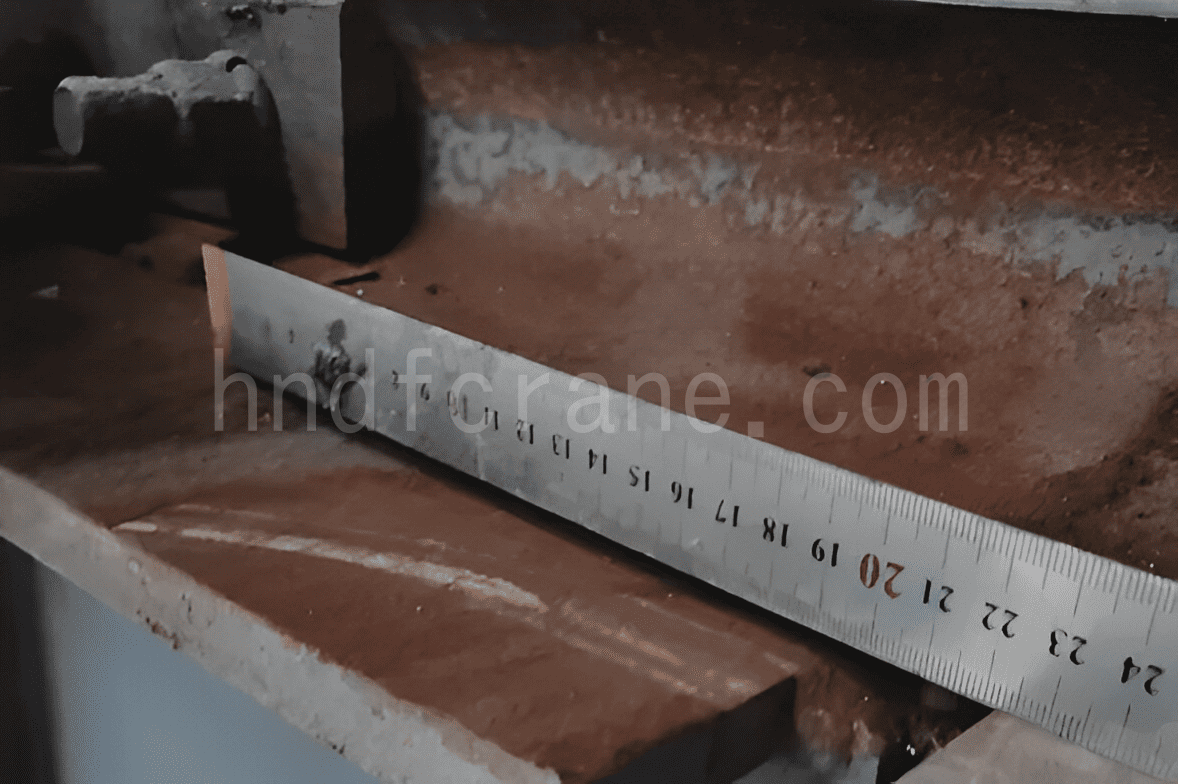เสียงผิดปกติของเครนเหนือศีรษะ: สาเหตุทั่วไป 5 ประการและวิธีแก้ไขที่ได้ผล
สารบัญ
เสียงดังผิดปกติจากเครนเหนือศีรษะเป็นปัญหาทั่วไปในการใช้งานเครนสะพาน บทความนี้วิเคราะห์สาเหตุของเสียงดังผิดปกติในการใช้งานเครนเหนือศีรษะ โดยระบุปัจจัยที่อาจเกิดขึ้น 5 ประการ ได้แก่ กลไกการเคลื่อนที่ของเครน รางเครน คานรันเวย์เครน การทรุดตัวของฐานราก และระบบไฟฟ้า นอกจากนี้ บทความนี้ยังให้แนวทางแก้ไขสำหรับปัญหาเสียงดังที่ระบุไว้ โดยหวังว่าบทความนี้จะเป็นประโยชน์กับคุณ
การวิเคราะห์สาเหตุของเสียงผิดปกติจากเครนเหนือศีรษะ
เสียงผิดปกติที่อธิบายไว้ในบทความนี้หมายถึงเครนเหนือศีรษะในสภาพเดิมที่ไม่มีการเปลี่ยนชิ้นส่วน เช่น ล้อ กลไกขับเคลื่อน หรือมอเตอร์ เสียงผิดปกติที่เกิดจากการเปลี่ยนอุปกรณ์เครนไม่อยู่ในขอบเขตของบทความนี้
1. สาเหตุของกลไกการเคลื่อนที่ของเครนเหนือศีรษะ
(1) สาเหตุของล้อเครน
เสียงผิดปกติของเครนเหนือศีรษะที่เกิดจากล้อเครนถือเป็นเรื่องปกติในการใช้งานจริง และสาเหตุหลักๆ ได้แก่:
- การวางตำแหน่งล้อที่ไม่ถูกต้องในแนวนอนหรือแนวตั้งมากเกินไป ทำให้เกิดแรงเสียดทานและการชนกันอย่างต่อเนื่องระหว่างล้อและรางในระหว่างการทำงานของเครน
- การหล่อลื่นตลับลูกปืนล้อที่ไม่ดี ทำให้มีแรงต้านทานในการทำงานเพิ่มขึ้น และตลับลูกปืนเสียหาย ซึ่งทำให้เกิดการติดขัดและมีเสียงผิดปกติ
- การสึกหรอมากเกินไปของหน้าแปลนล้อและรางรันเวย์เครน
(2) สาเหตุของล้อนำทาง
ล้อนำทางของเครนเป็นล้อที่มีแกนแนวตั้งซึ่งช่วยให้เครนหรือรถเข็นเคลื่อนที่ไปตามรางในทิศทางที่ถูกต้อง การติดตั้งหรือปรับล้อนำทางที่ไม่เหมาะสมอาจทำให้เกิดแรงเสียดทานหรือการชนกันระหว่างล้อนำทางและรางเครน ส่งผลให้เกิดเสียงดังผิดปกติ ดังที่แสดงในรูปที่ 1 การสึกหรอของล้อนำทางอาจรุนแรงมาก

(3) กลไกการขับเคลื่อนสาเหตุ
กลไกการขับเคลื่อนของเครนที่กล่าวถึงในบทความนี้ใช้กลไกการขับเคลื่อนแบบ “สามในหนึ่ง” เป็นตัวอย่าง แม้ว่าจะเรียกระบบที่จัดวางแยกกันก็ได้ สาเหตุหลักของเสียงผิดปกติในกลไกการขับเคลื่อน ได้แก่:
- เสียงผิดปกติจากตัวลดเกียร์ “สามในหนึ่ง” การสึกหรอของเกียร์ หรือฟันเฟืองหัก
- เบรก 2 ตัวขึ้นไปไม่ซิงโครไนซ์ เสียหาย หรือหายไป (ดังแสดงในรูปที่ 2)
- แผ่นบัฟเฟอร์ที่สึกหรอ (ดังแสดงในรูปที่ 3)


(4) สาเหตุคานหลักของเครน
สาเหตุหลักของเสียงดังผิดปกติในกลไกการเคลื่อนที่ของเครนซึ่งเกิดจากคานหลักของเครน ได้แก่:
- การดัดคานหลักของเครนในแนวนอนมากเกินไป ส่งผลให้แนวทแยงไม่ถูกต้อง
- การเปลี่ยนแปลงที่สำคัญในความโค้งของคานหลัก ส่งผลให้ฐานล้อของเครนมีการเปลี่ยนแปลง
2. สาเหตุของรางเครน
หลังจากใช้งานเครนเป็นเวลานาน โดยเฉพาะภายใต้ภาระงานเต็มที่ ความเครียดบนรางจะเพิ่มขึ้น ซึ่งอาจส่งผลให้เกิดเสียงดังผิดปกติระหว่างการทำงานของเครน หากการบำรุงรักษาไม่เพียงพอ ปัญหาอาจรุนแรงมากขึ้น สาเหตุหลักที่เกี่ยวข้องกับรางที่ทำให้เกิดเสียงดังผิดปกติ ได้แก่:
- การขันหรือคลายน็อตยึดรางไม่เพียงพอ (ดูรูปที่ 4) ส่งผลให้รางเสียรูปในบริเวณที่หลวม และส่งผลให้เกิดเสียงดังผิดปกติในระหว่างการเคลื่อนไหวของเครน
- ช่องว่างระหว่างรางและคานเครนมากเกินไป แผ่นรองขาดหายหรือวางไม่ถูกต้อง
- การจัดแนวที่ไม่ถูกต้องตามแนวตั้งของข้อต่อรางที่เชื่อมต่อด้วยแผ่นยึดเกินขีดจำกัดความคลาดเคลื่อนที่อนุญาต โดยไม่ได้รับการเจียรหรือปรับแต่ง ส่งผลให้เกิดเสียงดังผิดปกติเมื่อเครนเคลื่อนผ่าน
- การจัดแนวที่ไม่ถูกต้องของข้อต่อรางที่เชื่อมต่อด้วยแผ่นยึดแบบสลักในแนวนอน ส่งผลให้เกิดเสียงผิดปกติ การเชื่อมต่อแผ่นยึดแบบสลักมีช่องว่างมากเกินไป (ดูรูปที่ 5)
- ความเรียบของรอยต่อรางที่เชื่อมไม่เพียงพอ ทำให้เกิดรอยแตกร้าวหรือรอยต่อหลุดออก
- ขาดตัวหนีบรางทำให้เกิดเสียงผิดปกติ
- ความเบี่ยงเบนที่มากเกินไปในการจัดแนวแนวนอนหรือแนวตั้งของรางตามความยาว
- ช่วงรางเกินค่าเบี่ยงเบนที่อนุญาต
- ความสูงต่างกันเกินระหว่างด้านบนของรางคู่ขนานทั้งสอง
- การชดเชยตามยาวของตำแหน่งรอยต่อรางระหว่างรางขนานทั้งสองรางไม่ถูกต้องหรือไม่เพียงพอ
- ด้านข้างรางสึกหรอมาก


3. สาเหตุของคานรันเวย์เครน
- การเบี่ยงเบนลงมากเกินไปของคานเหล็กรันเวย์ หรือการดัดโค้งด้านข้างของคาน
- ข้อต่อหลวมในคานรันเวย์
- สลักเกลียวที่เชื่อมต่อคานรันเวย์หลวมหรือหายไป
- ความสูงต่างเกินระหว่างคานที่อยู่ติดกัน (ดูรูปที่ 6)
- การแตกร้าวหรือการแตกหักของชั้นยาแนวคอนกรีตหรือชั้นปรับระดับระหว่างคานเครนคอนกรีตและราง

4. สาเหตุของการทรุดตัวของมูลนิธิ
การทรุดตัวของฐานรากหมายถึงการอัดตัวของชั้นดินภายใต้แรงกดเพิ่มเติม ซึ่งนำไปสู่การทรุดตัวของพื้นผิว การทรุดตัวมากเกินไป โดยเฉพาะการทรุดตัวที่ไม่เรียบ อาจทำให้ตัวอาคารเอียง แตกร้าว และไม่สามารถใช้งานได้ การทรุดตัวของฐานรากเป็นปัญหาทั่วไปที่เกี่ยวข้องกับโครงสร้างโรงงานทั้งหมด อาจตั้งแต่การทรุดตัวในพื้นที่เล็ก ๆ เพียงไม่กี่เมตรไปจนถึงการทรุดตัวโดยรวมขนาดใหญ่หลายสิบเมตร
การทรุดตัวในพื้นที่อาจทำให้ส่วนหนึ่งของคานรันเวย์ทรุดตัวลง ส่งผลให้เกิดช่องว่างระหว่างคานที่ทรุดตัวลงและรางเครน (ดูรูปที่ 7) ช่องว่างดังกล่าวทำให้เกิดเสียงผิดปกติในระหว่างการทำงานของเครนเนื่องจากแรงกดบนรางที่เพิ่มขึ้น หากไม่ได้รับการซ่อมแซมและปรับปรุงอย่างเหมาะสมในระยะยาว อาจทำให้รางเครนในบริเวณที่ได้รับผลกระทบเกิดการเสียรูปถาวรหรือเสียหายได้

การทรุดตัวโดยรวมเป็นรูปแบบการทรุดตัวของฐานรากที่รุนแรงกว่า ส่งผลให้คานรันเวย์ทรุดตัวลงเป็นวงกว้าง การทรุดตัวที่ไม่เสมอกันทำให้ความสูงเปลี่ยนแปลงหรือเกิดการเสียรูปในแนวนอนของคานรันเวย์ ซึ่งส่งผลให้รางเครนเกิดการเสียรูปในแนวตั้งหรือแนวนอนตามมา ในระหว่างการทำงานของเครน เสียงที่ผิดปกติจะดังขึ้น ทำให้การทำงานด้วยความเร็วสูงทำได้ยากหรืออาจเป็นไปไม่ได้เลย
5. สาเหตุจากไฟฟ้า
แม้ว่าในกรณีส่วนใหญ่ที่เครนเหนือศีรษะมีเสียงดังผิดปกติขณะทำงานมักเกิดจากปัญหาทางกลไก แต่ก็มีปัจจัยทางไฟฟ้าบางอย่างที่ส่งผลได้เช่นกัน เช่น การเชื่อมต่อที่หลวมหรือไม่ดีในมอเตอร์หรือสายไฟเบรก รวมถึงความเสียหายหรือการสึกหรอของผ้าเบรก
แนวทางแก้ไขสำหรับเครนเหนือศีรษะที่มีเสียงดังผิดปกติ
สาเหตุของเสียงผิดปกติในการทำงานของเครนเหนือศีรษะแต่ละสาเหตุจะได้รับการแก้ไขพร้อมวิธีการแก้ไขที่สอดคล้องกัน
1. โซลูชันกลไกการเคลื่อนที่ของเครน
(1) โซลูชั่นล้อเครน
- สำหรับปัญหาการจัดตำแหน่งแนวนอนหรือแนวตั้งที่ไม่ถูกต้องมากเกินไป ล้อเครนควรวัดปริมาณการปรับก่อน โปรดดูที่ จี/ที 14405-2011และทำการปรับตามค่าที่วัดได้ เมื่อปรับความคลาดเคลื่อนในแนวนอน ให้วางชิมในระนาบแนวตั้งของชุดล้อ และหากปรับความคลาดเคลื่อนในแนวตั้ง ให้วางชิมในระนาบแนวนอน หลังจากปรับแล้ว ให้ทดสอบการทำงานและตรวจสอบช่องว่างระหว่างล้อเครนและราง
- หากมีปัญหาที่การหล่อลื่นตลับลูกปืนล้อไม่ดีจนทำให้มีแรงต้านทานในการทำงานเพิ่มขึ้น ควรเติมจารบีหล่อลื่นทันที หลังจากนั้น ให้ทำการทดสอบเพื่อตรวจสอบความยืดหยุ่นของตลับลูกปืน หากความเสียหายของตลับลูกปืนทำให้เกิดการติดขัดหรือมีเสียงผิดปกติ ควรเปลี่ยนตลับลูกปืนทันทีเพื่อป้องกันปัญหาเพิ่มเติม
- หากหน้าแปลนล้อเครนและรางสึกหรอมากเกินไป ให้ตรวจสอบสาเหตุของการสึกหรอก่อน เช่น ล้อตั้งตรงเกินไปหรือติดตั้งรางไม่ถูกต้อง การสึกหรอตามปกติของหน้าแปลนล้อสามารถปล่อยทิ้งไว้ได้ แต่หากการสึกหรอเกิน 40% ของความหนาที่ออกแบบไว้ของหน้าแปลน ควรเปลี่ยนล้อ
(2) โซลูชั่นล้อนำทาง
หากมีเสียงดังผิดปกติอันเนื่องมาจากการติดตั้งหรือปรับล้อนำทางไม่ถูกต้อง ให้ปรับช่องว่างระหว่างล้อนำทางและรางเพื่อให้แน่ใจว่ามีช่องว่างระหว่างการทำงานของเครนหรือมีแรงเสียดทานหรือการชนกันน้อยที่สุด ตรวจสอบว่าบล็อกตำแหน่งเหมาะสมหรือไม่ หากไม่เหมาะสม ให้ปรับใหม่ ดู GB/T 10183.1-2018 เพื่อตรวจสอบความคลาดเคลื่อนของความขนานตามแนวแกนของล้อนำทางแนวนอนทั้งในทิศทางตั้งฉากกับและตามรางเครน ตลอดจนความคลาดเคลื่อนของความสูง ปรับพื้นที่ใดๆ ที่ค่าจริงเกินค่าคลาดเคลื่อน
(3) โซลูชันกลไกการขับเคลื่อน
- หากเกิดเสียงดังผิดปกติจากตัวลดเกียร์แบบ “สามในหนึ่ง” ให้ตรวจสอบตำแหน่งที่เกิดเสียงดัง หากเฟืองสึกหรอหรือมีฟันเฟืองหัก ควรเปลี่ยนเฟืองใหม่
- หากเบรกสองตัวหรือมากกว่านั้นไม่ซิงโครไนซ์กัน ให้ตรวจสอบว่าเบรกทำงานอย่างถูกต้องหรือไม่ ใช้เครื่องวัดระยะวัดระยะเพื่อวัดช่องว่างของเบรกและตรวจสอบว่าตรงตามข้อกำหนดที่กำหนดหรือไม่ หากไม่เป็นเช่นนั้น ให้ปรับช่องว่างให้เหมาะสม
- หากผ้าเบรกหรือผ้าเบรกชำรุด ควรเปลี่ยนใหม่และตรวจสอบเป็นประจำ
(4) โซลูชันคานหลักเครน
โดยทั่วไปคานหลักของเครนจะไม่เสียรูปได้ง่าย หากเกิดการเสียรูป จำเป็นต้องตรวจสอบว่าการออกแบบเหมาะสมหรือไม่ การผลิตเป็นไปตามข้อกำหนดการออกแบบหรือไม่ กระบวนการผลิตเป็นไปตามมาตรฐานการก่อสร้างหรือไม่ และการติดตั้งเครนเป็นไปตามมาตรฐานหรือไม่ สำหรับปัญหาต่างๆ เช่น การดัดคานหลักในแนวนอนมากเกินไปหรือการเปลี่ยนแปลงความโค้งอย่างมีนัยสำคัญ มักจะใช้วิธีการซ่อมแซม เช่น การเสริมความแข็งแรงให้กับรอยเชื่อมหรือใช้เปลวไฟในการให้ความร้อน การซ่อมแซมมักต้องให้ผู้ผลิตหรือทีมงานมืออาชีพเข้ามาเกี่ยวข้อง การตรวจสอบคานหลักสามารถดำเนินการได้โดยอ้างอิงตาม GB/T 14405-2011
2. โซลูชั่นรางเครน
การจัดการรางเครนควรเน้นการบำรุงรักษาและการบำรุงรักษาตามปกติเพื่อแก้ไขปัญหาในช่วงเริ่มต้น ป้องกันไม่ให้เกิดความเสียหายต่ออุปกรณ์
- สำหรับปัญหาที่น็อตยึดรางขันแน่นไม่เพียงพอหรือหลวม ควรใช้การตรวจสอบตามปกติร่วมกับการบำรุงรักษาตามกำหนดเวลาเพื่อให้แน่ใจว่าขันน็อตให้แน่นอย่างถูกต้อง
- หากมีช่องว่างระหว่างรางและคานรันเวย์มากเกินไป หรือหากช่องว่างยาวเกินไป ให้ปรับคานรันเวย์เหล็กเพื่อให้ส่วนล่างของรางเข้าใกล้ด้านบนของคานมากขึ้น หากช่องว่างเกิน 200 มม. ให้ใช้แผ่นเสริมที่มีความยาวอย่างน้อย 100 มม. และกว้างกว่าฐานราง 10-20 มม. ไม่ควรใช้แผ่นเสริมเกิน 3 แผ่นต่อชุด และควรเชื่อมแผ่นเสริมเข้ากับคานเหล็กอย่างแน่นหนา สำหรับคานคอนกรีต ให้ใช้วิธีการที่คล้ายกับคานเหล็ก ไม่แนะนำให้ใช้แผ่นเสริมแบบยืดหยุ่นเนื่องจากสึกหรอบ่อยครั้งตามกาลเวลา
- หากรอยต่อรางแผ่นยึดมีการจัดแนวที่ไม่ถูกต้องในแนวตั้งหรือแนวนอนมากเกินไป ให้ตรวจสอบรอยต่อรางแผ่นยึด หากพบการสึกหรอมากเกินไป ให้เปลี่ยนแผ่นยึด จากนั้นปรับรอยต่อรางและรางเพื่อให้แน่ใจว่าการจัดแนวที่ไม่ถูกต้องในแนวตั้งและแนวนอนไม่เกิน 1 มม. และช่องว่างที่รอยต่อรางไม่เกิน 2 มม. ในพื้นที่ที่มีความแตกต่างของอุณหภูมิ 20°C ขึ้นไป หรือระหว่างการติดตั้งในฤดูหนาว ให้พิจารณาช่องว่างระหว่างรอยต่อ 4-6 มม. ใช้ไม้บรรทัดเหล็กและเกจวัดระยะสำหรับการวัด
- หากรอยเชื่อมรางไม่เรียบพอ ให้ใช้ล้อเจียรเพื่อขัดด้านบนและด้านข้างของรอยเชื่อมให้เรียบตามมาตรฐานรอยเชื่อมรางที่กำหนด หากรอยเชื่อมรางแตกร้าวหรือหลวม ควรให้ช่างเชื่อมเฉพาะทางที่มีวัสดุและกระบวนการเฉพาะเป็นผู้ดำเนินการซ่อมแซม เนื่องจากระบบรางเครนมีความซับซ้อน จึงยังคงมีความเสี่ยงที่จะแตกร้าวหรือคลายตัวหลังจากเชื่อม ดังนั้น ขอแนะนำให้เชื่อมรอยเชื่อมรางเครนบนสะพานด้วยแผ่นเพลทแทนการเชื่อม
- สำหรับเสียงผิดปกติที่เกิดจากการที่ตัวหนีบรางหายไป ให้ตรวจหาส่วนประกอบที่หายไปและยึดให้แน่นเพื่อให้แน่ใจว่าเครนทำงานได้ตามปกติ
- หากมีความเบี่ยงเบนในแนวนอนหรือแนวตั้งมากเกินไปตลอดความยาวของราง ให้ปรับรางเพื่อให้ความเบี่ยงเบนในแนวนอนไม่เกิน 1 มม. ตลอดความยาว 2 เมตร และค่าเบี่ยงเบนในแนวตั้งไม่เกิน 2 มม. การวัดสามารถทำได้โดยใช้ลวดเหล็ก
- สำหรับค่าเบี่ยงเบนช่วงรางเครนที่เกินค่าความคลาดเคลื่อนที่อนุญาต ให้ปรับรางเพื่อให้แน่ใจว่าค่าเบี่ยงเบนช่วงที่อนุญาตสูงสุด ΔS จะเป็นดังต่อไปนี้:
- เมื่อ S≤16 ม. △S =±5 มม.
- เมื่อ S>16 ม. △S =±[5+0.25(S-16)]มม.
- ΔS: ความเบี่ยงเบนช่วงรางเครน
- S: ช่วงรางเครน
- ค่าเบี่ยงเบนสูงสุดต้องไม่เกิน ±15 มม. สำหรับการใช้งานเฉพาะ โปรดดู GB/T 10183.1-2018 สามารถวัดช่วงรางเครนได้โดยใช้เทปเหล็กและสเกลสปริง
- หากความสูงต่างกันมากเกินไประหว่างส่วนบนของรางเครนขนานสองอัน ให้ปรับคานและรางของรันเวย์เพื่อให้แน่ใจว่าความสูงต่างกันไม่เกิน 10 มม. ใช้ระดับน้ำเพื่อวัดหลายๆ ครั้ง
- สำหรับข้อต่อรางขนานที่ไม่ได้เหลื่อมกันตามยาวหรือมีระยะเหลื่อมกันไม่ถูกต้อง ให้ปรับรางเพื่อให้แน่ใจว่าระยะห่างไม่น้อยกว่า 600 มม. และไม่ตรงกับระยะฐานล้อของล้อหน้าและล้อหลังของเครน
- หากการสึกหรอที่ด้านข้างรางเกิน 15% ของความกว้างรางเดิม จะต้องเปลี่ยนราง
3. โซลูชั่นคานรันเวย์
คุณภาพของคานรันเวย์ถือเป็นรากฐานในการรับประกันคุณภาพของการติดตั้งราง ก่อนติดตั้งราง จำเป็นต้องตรวจสอบให้แน่ใจว่าค่าเบี่ยงเบนในการติดตั้งของคานรันเวย์เป็นไปตามมาตรฐานที่กำหนด จะต้องดำเนินการตรวจสอบคานรันเวย์อย่างละเอียดก่อนติดตั้งราง และควรทำเครื่องหมายฐานของคานรันเวย์ระหว่างการตรวจสอบ ซึ่งสามารถวัดได้โดยใช้กล้องสำรวจ ในขณะที่สามารถวัดระดับได้โดยใช้อุปกรณ์ปรับระดับ
การยอมรับคานรันเวย์เหล็กต้องปฏิบัติตาม GB 50205-2017 ในขณะที่การยอมรับคานรันเวย์คอนกรีตเสริมเหล็กต้องปฏิบัติตาม GB 50204-2015 ปัจจุบันยังไม่มีมาตรฐานเฉพาะสำหรับคานรันเวย์คอนกรีตผสมเหล็ก
- สำหรับปัญหาต่างๆ เช่น การเบี่ยงเบนลงมากเกินไปหรือการดัดโค้งด้านข้างของคานเหล็กของรันเวย์ จำเป็นต้องตรวจสอบว่าการออกแบบเป็นไปตามมาตรฐานที่กำหนดหรือไม่ และการติดตั้งมีคุณสมบัติเหมาะสมหรือไม่ สำหรับการซ่อมแซม อาจใช้วิธีการให้ความร้อนเพื่อแก้ไขคาน
- หากข้อต่อหลวมหรือสลักเกลียวหลวมและหายไปในคานรันเวย์ ควรซ่อมแซมโดยการเชื่อมและขันสลักเกลียวให้แน่น หากความสูงแตกต่างกันมากเกินไประหว่างคานที่อยู่ติดกัน ให้ปรับความสูงของคานรันเวย์ข้างเคียงเพื่อลดการเบี่ยงเบนของความสูง
- หากชั้นยาแนวคอนกรีตหรือชั้นปรับระดับระหว่างคานเครนคอนกรีตและรางได้รับความเสียหาย ให้ตรวจสอบความหนาของชั้นหล่อรอง หากความหนาไม่เพียงพอ แนะนำให้ใช้วิธีอื่น หากความหนาเพียงพอ ควรตั้งแม่พิมพ์ใหม่เพื่อเทปูนซีเมนต์ และเมื่อปูนซีเมนต์แข็งตัวอย่างเหมาะสมแล้ว เครนก็สามารถกลับมาทำงานได้อีกครั้ง
4. โซลูชันการชำระฐานราก
การทรุดตัวของฐานรากในระยะเริ่มต้นเป็นเหตุการณ์ที่เกิดขึ้นได้ค่อนข้างบ่อย เมื่อเทคโนโลยีฐานรากมีความก้าวหน้ามากขึ้น ปัญหาการทรุดตัวในระดับใหญ่ก็เกิดขึ้นน้อยลง แม้ว่าการทรุดตัวเฉพาะจุดจะยังคงเกิดขึ้นเป็นครั้งคราวก็ตาม การทรุดตัวเฉพาะจุดมีแนวโน้มที่จะเกิดขึ้นในระดับเล็กแต่ยังคงต้องมีการป้องกันและการรักษา
(1) การป้องกัน: สามารถตรวจสอบการตั้งถิ่นฐานได้โดยการตั้งจุดตรวจสอบการตั้งถิ่นฐาน วิธีการปรับระดับที่แม่นยำมักใช้ในการวัดปริมาณการทรุดตัว
(2) การบำบัด: สำหรับการทรุดตัวของคานรันเวย์ที่เกิดจากการทรุดตัวของฐานราก ควรทำการซ่อมแซมโดยผู้เชี่ยวชาญเพื่อขจัดการทรุดตัว และแก้ไขปัญหาเสียงผิดปกติในระหว่างการทำงานของเครน หากการทรุดตัวในบริเวณนั้นมีขนาดเล็ก สามารถใช้แผ่นเสริมระหว่างคานรันเวย์และรางได้ แต่ต้องยึดแผ่นเสริมอย่างแน่นหนาเพื่อป้องกันไม่ให้หลุดออกในระหว่างการทำงานของเครน
5. วิธีแก้ไขความผิดพลาดทางไฟฟ้า
สำหรับเสียงผิดปกติของเครนเหนือศีรษะที่เกิดจากการเชื่อมต่อที่หลวมหรือผิดพลาดในมอเตอร์เครนหรือสายไฟเบรก ควรขันขั้วต่อทันทีและกำหนดเวลาตรวจสอบเป็นประจำ หากผ้าเบรกชำรุด ควรเปลี่ยนใหม่ หากผ้าเบรกสึก ให้ตรวจสอบสายไฟก่อนเพื่อให้แน่ใจว่าทำงานได้อย่างถูกต้อง จากนั้นสังเกตผ้าเบรก หากเกิดความล้มเหลวเป็นระยะๆ ให้เปลี่ยนผ้าเบรก และหากมีชิ้นส่วนอะไหล่เพียงพอ ให้ดำเนินการเปลี่ยนเพื่อป้องกันปัญหาในอนาคต
บทสรุป
การแก้ไขปัญหาเสียงผิดปกติของเครนเหนือศีรษะถือเป็นสิ่งสำคัญเพื่อให้การทำงานของเครนเป็นไปอย่างราบรื่นและป้องกันปัญหาทางกลไกอื่นๆ ที่อาจเกิดขึ้นได้ โดยการทำความเข้าใจสาเหตุทั่วไปและนำโซลูชันที่เหมาะสมมาใช้ ผู้ปฏิบัติงานสามารถลดระยะเวลาหยุดทำงานและการซ่อมแซมที่มีต้นทุนสูงได้อย่างมาก
อ้างอิง: การวิเคราะห์และแนวทางแก้ไขสำหรับเสียงรบกวนที่ผิดปกติในการทำงานของเครนเหนือศีรษะ
ส่งคำถามของคุณ
- อีเมล: sales@hndfcrane.com
- วอทส์แอพพ์: +86-191 3738 6654
- โทร: +86-373-581 8299
- แฟกซ์: +86-373-215 7000
- เพิ่ม: Changnao Industrial District, Xinxiang City, Henan Province, China










































































